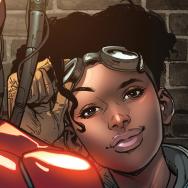From poetry to non-fiction to plays and podcasts, Asst. Prof. Eve L. Ewing’s work spans genres, decades and neighborhoods—but most of it is anchored in the city of Chicago, usually the South Side.
This connection is especially evident in one of the School of Social Service Administration scholar’s more buzzed-about projects: writing for the Marvel series Ironheart. Ironheart is the story of 15-year-old Riri Williams—supergenius, superhero, and South Side resident. UChicago Arts caught up with Ewing to talk about her work on Ironheart and her own relationship with comic books.
Since writing Ironheart, has your appetite for or the way you read comics changed?
I’ve talked for years about how all writers can learn something from comics and cartooning, in the same way that I think all writers can learn something from poetry. So I think I was always attuned to that. But now I spend a lot more time reading comics featuring specific characters to delve really heavily into their backstory. Sometimes one thing leads to the next, and I end up in kind of a wormhole, reading issue after issue about some D-list character from the ‘80s that no one is thinking about. I find myself reading comics less for pleasure per se, and more to see who and what is hidden in the backlog that I might want to elevate or just muse over.
What was—if anything—missing for you in comics that you read growing up, and what do you think the character of Riri provides for children today?
Well, just a friendly reminder that comics are for people of all ages, not just children, and in some cases not children at all! One thing is that comics, especially superhero comics have been notorious for the way they have depicted young women. It was definitely frustrating that even some of the awesome and exciting female characters would be drawn with just absurd body proportions, and when Riri was first announced as a character there was some (I think necessary) pushback about a couple of renderings where she was really hypersexualized. And it was like ... this is a 15-year-old girl, y’all. Let’s not do this. So I really appreciate working with an artist who is a dream collaborator, Luciano Vecchio, who puts such care and reflection into all of the characters, and for my part I work to build a character who is smart, interesting, three-dimensional, engaging, and has a lot to offer readers besides her looks and even her abilities.
Your sociological work is so rooted in Chicago—your book Ghosts in the Schoolyard is about the 2013 Chicago school closings, and you went to and taught at Chicago Public Schools where teens like Riri Williams would attend. How did that inform your narrative for this series?
It’s a big, wide Marvel universe out there, and sometimes Riri will be at home, sometimes not. But when she is, it’s so fun to get really detailed about how the city serves as a backdrop for her life. Some of the visual referents I want to share with Luciano aren't things you can find pictures of, so a couple times I’ve gone on Google Street View and taken screenshots to send him, like, this is what this corner looks like. Aside from just specific places, I think Riri’s vision of “good” and “evil” is a little more nuanced than some other characters’ might be. Growing up around a lot of regular people who face regular struggles informs her understanding of why people sometimes do things that they shouldn’t and end up in situations beyond their control.
What sort of research went into your version of Riri?
I spent a lot of time reading the presence she’d already had in other titles, and thinking about what fundamental questions arose for me as I encountered her character. The first one, which was the biggest one for me, was: Why do you do what you do? And so I knew that I wanted to set about answering that question in Issue 1. I also reflected quite a bit on other characters who I think are analogous in some ways, and thought about what makes them work, what makes them effective, and what makes them tick, and tried to think about the most important aspects of world-building that Riri would need to feel really robust. I also had a lot of helpful conversations with other writers who were extremely generous in giving me mentorship, support and feedback.
In a decade, where do you envision Riri in the superhero canon?
Sometimes people say “there are no black superheroes” or they only know about Black Panther and Storm, and I think that’s such a shame because there are lots of really interesting black characters out there. They maybe just haven’t had the same opportunities to be front and center and to connect with audiences over time. I think it would be amazing for Ironheart to really shine for multiple generations, for the kids who are reading her now in third or fourth grade to be able to stick with her over time, grow with her and see her as a classic character.
What do you hope Ironheart evokes in young readers?
I think we need different identities and voices represented in media, but it also matters what that representation looks like, what it sounds like, what its politics are, and what people get to do. I grew up reading a lot of fantasy literature about British children in trousers or elves or whatever going on adventures, and those works made a huge impact on me. But seeing a little girl who looked like me going on this amazing, otherworldly adventure ... I don’t think I understood how badly I needed that. With Ironheart, it’s funny, I often feel the same way. Often when I get drafts of the art in it, it makes me cry. Even reading lines I literally wrote myself makes me cry! I think there’s something in us that feels small, that feels unseen, that’s been waiting for a long time for a glimmer of recognition, and when a light shines on it, something bursts.
This interview was edited and condensed from the Spring 2019 edition of the UChicago Arts Magazine.

